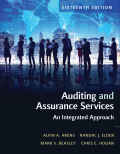
EBK AUDITING AND ASSURANCE SERVICES
16th Edition
ISBN: 8220102019720
Author: Hogan
Publisher: PEARSON
expand_more
expand_more
format_list_bulleted
Question
Chapter 26, Problem 1RQ
To determine
Explain the nature of the categories of standards in the IIA International Standards for the professional practice of internal auditing.
Expert Solution & Answer
Explanation of Solution
Attribute Standards
- 1000 Purpose, authority and responsibility: This standard state that the purpose, authority and responsibility of the internal audit activities must be formally defined in the internal audit charter.
- 1100 Independence and objectivity: This standard states that the auditor must perform the activities independently and in an unbiased manner. It also states that the auditor must be objective and no quality compromises are made.
- 1200 Proficiency and due professional care: This standard states that the auditor must possess the professional knowledge and skills to carry out their professional responsibilities. The auditors must apply their skills in a careful manner while performing their professional duties.
- 1300 Quality assurance and Improvement program: This standard state that there must be a quality assurance and improvement program developed and maintained by the chief audit executive. This program helps to evaluate the efficiency of the audit activities and identifies opportunities of improvement
Performance standards
- 2000 Managing the internal audit activities: This standard state that the chief audit executive must manage the audit activities efficiently so that it can benefit the organization.
- 2100 Nature of work: This standard state that the audit activities must help the organization to make its governance, risk management and control processes more effective and efficient.
- 2200 Engagement planning: This standard state that each engagement must be planned keeping in view the organizations objectives, strategies and risks involved.
- 2300 Performing the engagement: This standard state that the internal auditor must collect, analyze and store the information required to achieve the engagement’s objective.
- 2400 Communicating results: This standard state that the results must be communicated by the internal auditor.
- 2500 Monitoring process: This standard state that the disposition results communicated must be monitored by a system established by the chief audit executive of the company.
- 2600 Communicating the acceptance of risks: This standard state that if the reports conclude that the company has accepted a high-level risk to the company then the chief audit executive must communicate this information to the senior management or to the board of directors if needed
Want to see more full solutions like this?
Subscribe now to access step-by-step solutions to millions of textbook problems written by subject matter experts!
Students have asked these similar questions
What are the functions of an external audit, according to the International Auditing and Assurance Standards Board?
How do IAASB audit standards compare to US audit standards?
Discuss why we have a dual system of auditing standards in the U.S. (AICPA Auditing Standards Committee-Statement on Auditing Standards and the PCAOB-Auditing Standards). Be certain to identify when each system used.
Chapter 26 Solutions
EBK AUDITING AND ASSURANCE SERVICES
Ch. 26 - Prob. 1RQCh. 26 - Prob. 2RQCh. 26 - Prob. 3RQCh. 26 - Prob. 4RQCh. 26 - Prob. 5RQCh. 26 - Prob. 6RQCh. 26 - Prob. 7RQCh. 26 - Prob. 8RQCh. 26 - Prob. 9RQCh. 26 - Prob. 10RQ
Ch. 26 - Prob. 11RQCh. 26 - Prob. 12RQCh. 26 - Prob. 13RQCh. 26 - Prob. 14RQCh. 26 - Prob. 15RQCh. 26 - Prob. 16.1MCQCh. 26 - Prob. 16.2MCQCh. 26 - Prob. 16.3MCQCh. 26 - Prob. 17.1MCQCh. 26 - Prob. 17.2MCQCh. 26 - Prob. 17.3MCQCh. 26 - Prob. 18.1MCQCh. 26 - Prob. 18.2MCQCh. 26 - Prob. 18.3MCQCh. 26 - Prob. 19.1MCQCh. 26 - Prob. 19.2MCQCh. 26 - Prob. 19.3MCQCh. 26 - Prob. 20DQPCh. 26 - Prob. 21DQPCh. 26 - Prob. 22DQPCh. 26 - Prob. 23DQPCh. 26 - Prob. 24DQPCh. 26 - Prob. 25DQP
Knowledge Booster
Similar questions
- How does the role of the SEC differ from that of the AICPA? Contrast the roles of the AICPA and the PCAOB in the development of auditing standards.arrow_forwardWhich of the following is an authoritative body that the AICPA Code of Professional Conduct authorizes to promulgate auditing and attestion?arrow_forwardWho created the International Auditing Standards?arrow_forward
- International Standards on Auditing (ISAs) are issued by the International Auditingand Assurance Standards Board (IAASB). Use the IAASB Web site (http://www.ifac.org/IAASB/) to learn more about the IAASB and its standard-setting activities.a. What is the objective of the IAASB? Who uses International Standards on Auditing?b. Summarize the due process followed by the IAASB in setting standards.c. How is the IAASB committed to transparency in the standard-setting process?arrow_forwardWhat are examples of some of the independence requirements by the AICPA concerning external auditors, and if the same requirements apply to internal auditors?arrow_forwardHow does AASB come up with Canadian Auditing Standards?arrow_forward
arrow_back_ios
arrow_forward_ios
Recommended textbooks for you
 Auditing: A Risk Based-Approach (MindTap Course L...AccountingISBN:9781337619455Author:Karla M Johnstone, Audrey A. Gramling, Larry E. RittenbergPublisher:Cengage Learning
Auditing: A Risk Based-Approach (MindTap Course L...AccountingISBN:9781337619455Author:Karla M Johnstone, Audrey A. Gramling, Larry E. RittenbergPublisher:Cengage Learning Auditing: A Risk Based-Approach to Conducting a Q...AccountingISBN:9781305080577Author:Karla M Johnstone, Audrey A. Gramling, Larry E. RittenbergPublisher:South-Western College PubBusiness/Professional Ethics Directors/Executives...AccountingISBN:9781337485913Author:BROOKSPublisher:Cengage
Auditing: A Risk Based-Approach to Conducting a Q...AccountingISBN:9781305080577Author:Karla M Johnstone, Audrey A. Gramling, Larry E. RittenbergPublisher:South-Western College PubBusiness/Professional Ethics Directors/Executives...AccountingISBN:9781337485913Author:BROOKSPublisher:Cengage

Auditing: A Risk Based-Approach (MindTap Course L...
Accounting
ISBN:9781337619455
Author:Karla M Johnstone, Audrey A. Gramling, Larry E. Rittenberg
Publisher:Cengage Learning

Auditing: A Risk Based-Approach to Conducting a Q...
Accounting
ISBN:9781305080577
Author:Karla M Johnstone, Audrey A. Gramling, Larry E. Rittenberg
Publisher:South-Western College Pub

Business/Professional Ethics Directors/Executives...
Accounting
ISBN:9781337485913
Author:BROOKS
Publisher:Cengage
